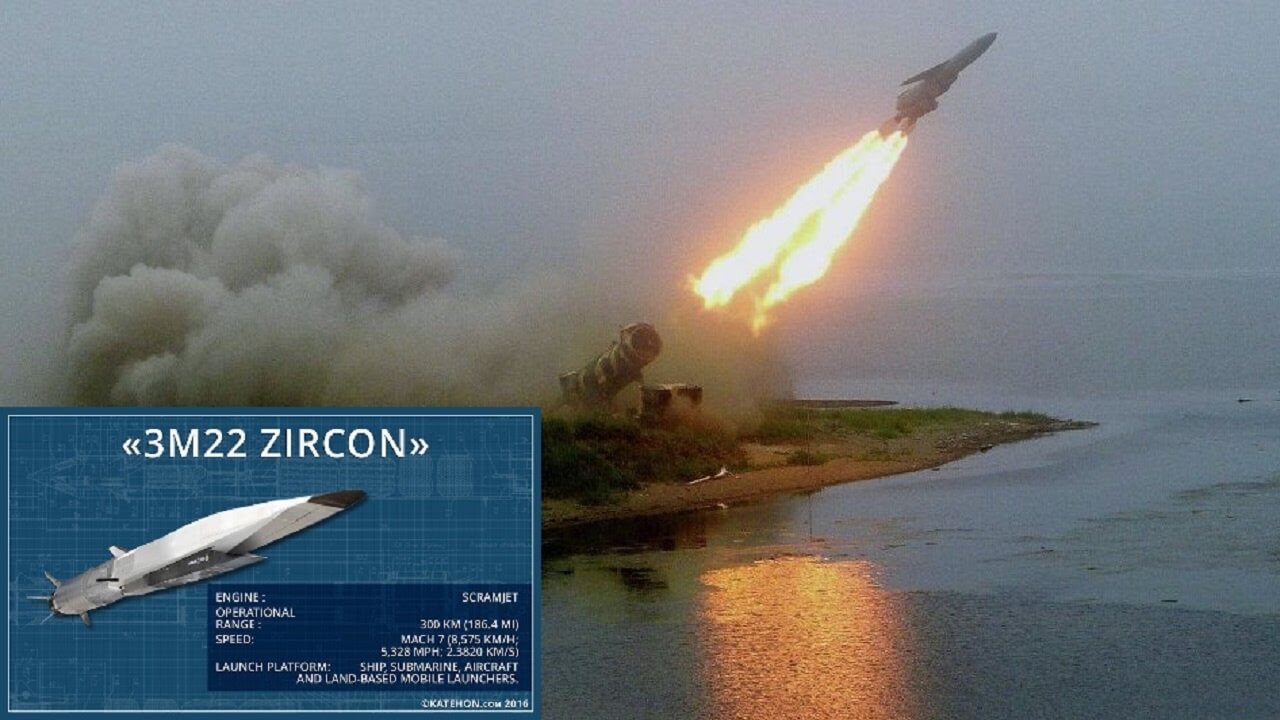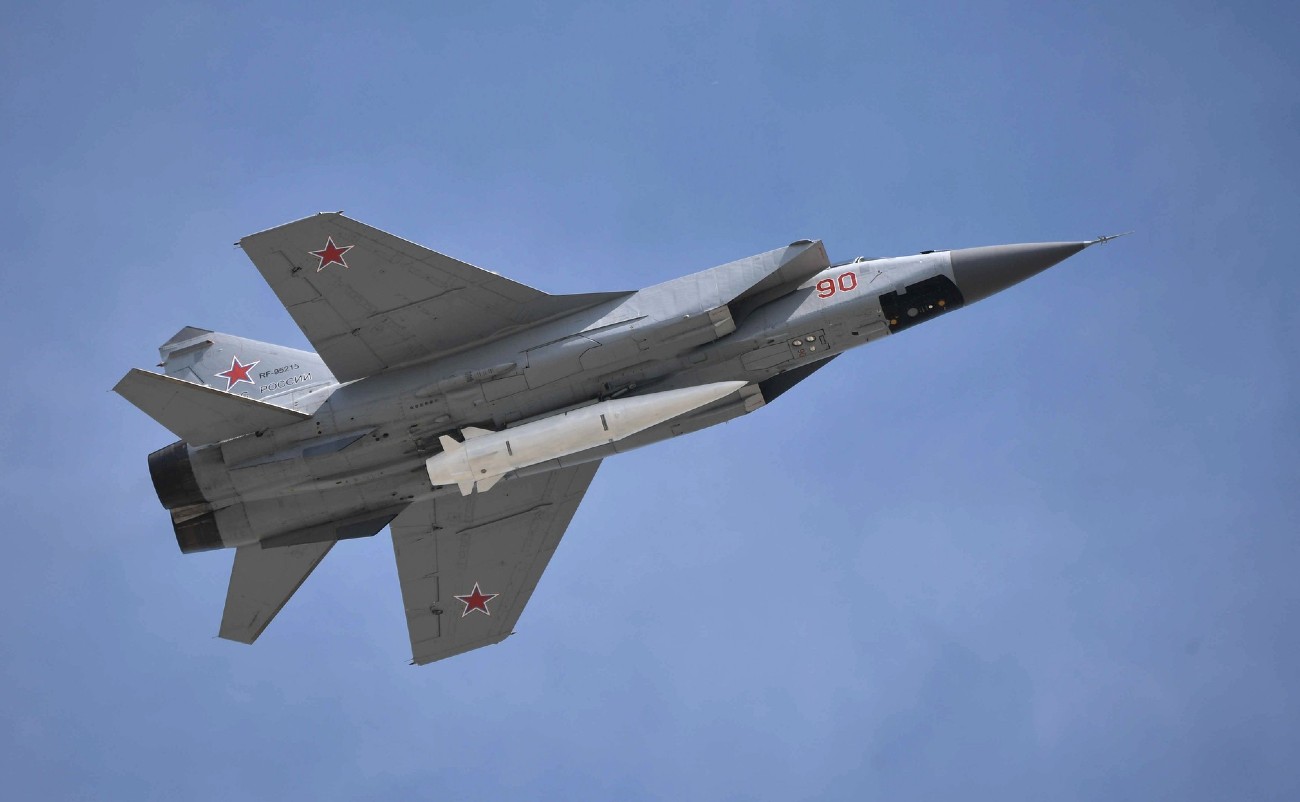According to RIA Novosti, President Putin, in his interaction with the press in China, stated that Russian Aerospace Forces (RuAF) are beginning to patrol the airspace over the Black Sea on an ongoing basis; aircraft are equipped with the Kinzhal missile.
The Kh-47M2 Kinzhal, referred to by the President, is an air-launched ballistic missile derived from Russia’s ground-launched 9K720 Iskander-M.
The missile was unveiled by President Putin in a message to the Federal Assembly on March 1, 2018. It was one of six new game-changing Russian weapons announced. The missile entered service in December 2017 in the Southern Military District.
During the course of the ongoing Special Military Operation (SMO) in Ukraine, the RuAF has launched Kinzhal missiles periodically from MiG-31K fighter aircraft. The missile has been used exclusively to strike very important hardened targets such as underground missile storage facilities and command and control centers.
Kinzhal Launch Platforms
Until recently, only the MiG-31K supersonic fighter and Tu-22M3M supersonic strategic bomber of the RuAf had the capability to launch the Kinzhal missile. In September, TASS reported that the Su-34 had, for the first time, launched a Kinzhal hypersonic missile.
“The Su-34 aircraft used the Kinzhal hypersonic missile during the air strike. The first crew that successfully completed such a task was nominated for state awards,” the agency’s interlocutor said.
Kinzhal Anti-Shipping Capability
When President Putin first revealed the existence of the Kinzhal missile, an animation showed the missile targeting naval vessels, alluding to such a capability.
Russian sources have always maintained that the missile is designed to target US and NATO warships posing a threat to strategic missile systems in Russia’s European part and to destroy NATO missile defense systems and ballistic missile defense ships and land objects close to Russia’s borders.
The Kinzhal is designed to overcome any known US air or missile defense systems, including MIM-104 Patriot, Terminal High Altitude Area Defense, and Aegis Combat System.
Western analysts have, however, been skeptical about the Kinzhal’s anti-shipping capability because such a capability would need the missile to feature an active radar seeker. There are technical challenges to developing an active seeker for a hypersonic missile because of the plasma cloud that forms around the missile at hypersonic speeds; the West is still struggling to overcome those challenges.
However, it is likely that Russia overcame the technical challenges before President Putin announced the existence of the Kinzhal. As things stand, there can be no doubt that Russia has developed and deployed active seekers that can work through the plasma layer.

Zircon Hypersonic Cruise Missile
On January 4, Russia operationally deployed the Zircon hypersonic anti-shipping cruise missile on Admiral Gorshkov after extensive testing. On December 16, 2021, in its last test before operational deployment, Admiral Gorshkov operating in the white sea, successfully struck a target with a Zircon at the Chizha training ground in the Arkhangelsk region.
The Zircon missile system is designated 3K22, while the missile has the designation 3M22.
The Zircon is powered by a Dual mode ramjet, unlike the Kinzhal, which is powered by a solid-fuel rocket motor. The missile, which is 10 to 11 m long, cruises at altitudes ranging from 30 to 40 km attaining speeds of around M 10. The 300 kg to 400 kg warhead of the missile, combined with its hypersonic speed, gives it a lot of destructive energy on impact, ensuring the destruction of any warship.
Kinzhal Far More Destructive Than Zircon
Kinzhal’s anti-ship capabilities pose a far greater threat to U.S. and NATO warships, aircraft carriers in particular, than Zircon for the following two good reasons.
The Kinzhal has a bigger warhead of between 710–800 kg and about the same speed as the Zircon. As such, the Kinzhal packs more destructive power than the Zircon.

The second reason is more persuasive. While Zircon launch platforms can be tracked and hence evaded by staying out of range, there is no knowing when a Kinzhal launch platform like a MiG-31K, Tu-22M3M, or Su-34 will come within range. The hypersonic speed of the missile rules out interception, and the destructive energy that the warhead packs could easily sink an aircraft carrier with one hit.
In other words, when a Kinzhal is in play, adversary warship destruction is guaranteed!
Conclusion
President Putin’s statement that RuAF aircraft are now patrolling overhead the Black Sea was likely aimed at Britain, which has frequently talked about bringing Royal Navy ships into the Black Sea in violation of the Montreux Convention.
What Putin actually, though not in the same words, was that Royal Navy warships would be annihilated if they force their way into the Black Sea.
- Vijainder K Thakur is a retired IAF Jaguar pilot. He is also an author, software architect, entrepreneur, and military analyst. VIEWS PERSONAL
- Follow the author @vkthakur




